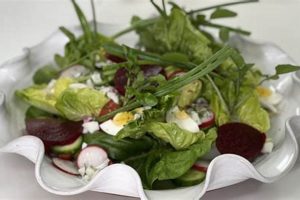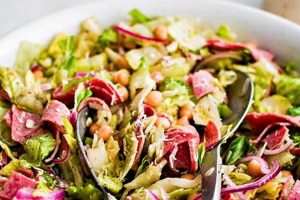This classic dessert salad typically combines a mixture of canned fruits, miniature marshmallows, and a creamy base of Cool Whip. Variations often include additions such as shredded coconut, chopped nuts, or other flavorings. A simple recipe might involve mandarin oranges, pineapple chunks, maraschino cherries, and mini marshmallows folded into the whipped topping.
Its popularity likely stems from the ease of preparation and readily available ingredients. Often served during potlucks, holidays, and family gatherings, this dish represents a nostalgic dessert for many, evoking memories of simpler times and shared meals. Its sweet and refreshing nature makes it a welcome addition to any buffet spread, especially during warmer months.
Further exploration will delve into specific recipe variations, nutritional information, tips for successful preparation, and potential adaptations for dietary restrictions. Discussions regarding the evolution of dessert salads and their place in culinary history will also be presented.
Tips for a Successful Dessert Salad
Careful preparation ensures a delightful and visually appealing dessert salad. Attention to detail, from ingredient selection to chilling time, contributes significantly to the overall experience.
Tip 1: Drain Canned Fruits Thoroughly: Excess liquid will thin the whipped topping and create a watery salad. Thorough draining prevents this issue, maintaining the desired consistency.
Tip 2: Use High-Quality Whipped Topping: Opting for a name-brand whipped topping generally yields a superior texture and flavor profile compared to generic alternatives.
Tip 3: Chill Ingredients Before Combining: Pre-chilled ingredients help maintain a cold temperature, preventing the whipped topping from melting prematurely.
Tip 4: Gently Fold Ingredients: Aggressive mixing can crush delicate fruit pieces and deflate the whipped topping. A gentle folding motion preserves the integrity of the components.
Tip 5: Add Nuts and Coconut Last: Incorporating these ingredients last prevents them from becoming soggy, maintaining their desired texture.
Tip 6: Chill Before Serving: Allowing the salad to chill for at least two hours allows the flavors to meld and the dessert to reach an optimal serving temperature.
Tip 7: Garnish Thoughtfully: A simple garnish, such as a sprinkle of chopped nuts or a few maraschino cherries, elevates the presentation.
Adhering to these tips ensures a dessert salad that is both visually appealing and palate-pleasing. The combination of chilled ingredients, careful mixing techniques, and thoughtful presentation contributes to a truly satisfying dessert experience.
By understanding the nuances of preparation, one can appreciate the simplicity and enduring appeal of this classic dessert.
1. Ingredients
Ingredient selection significantly impacts the final character of this dessert salad. Careful consideration of components contributes to the desired balance of sweetness, texture, and visual appeal. The following facets illustrate the crucial role ingredients play in defining this classic dish.
- Canned Fruit Cocktail:
This staple provides a foundational sweetness and textural diversity. The mixture of fruits, typically including peaches, pears, grapes, pineapple, and cherries, offers a complex flavor profile. Quality variations exist; premium brands often offer larger fruit pieces and a lighter syrup.
- Whipped Topping:
This ingredient contributes the characteristic creamy texture and airy lightness. While Cool Whip remains the traditional choice, variations exist, including homemade whipped cream or plant-based alternatives. The choice of whipped topping significantly influences the overall richness and flavor.
- Miniature Marshmallows:
These add a distinct sweetness and a soft, chewy texture. Their ability to absorb surrounding flavors adds depth to the overall profile. Variations can include flavored marshmallows or larger, cut marshmallows.
- Optional Additions:
These additions offer opportunities for customization and personalization. Common choices include shredded coconut, chopped nuts (such as pecans or walnuts), and maraschino cherries. These elements contribute additional texture, flavor, and visual interest.
The interplay of these ingredients defines the sensory experience of the dessert. The combination of fruit, whipped topping, and optional additions creates a harmonious balance of sweet, creamy, and texturally diverse elements. Understanding the role of each ingredient allows for informed choices, enabling customization and ensuring a consistently enjoyable result.
2. Preparation
Preparation methods significantly influence the final quality and presentation of this dessert salad. While seemingly simple, attention to detail during the assembly process ensures optimal texture, flavor melding, and visual appeal. The following facets highlight the crucial role of proper preparation techniques.
- Draining Excess Liquid:
Thorough draining of canned fruit is paramount. Residual liquid thins the whipped topping, resulting in a watery consistency and diluted flavor. Proper draining preserves the integrity of the whipped topping and prevents a soupy final product.
- Gentle Folding Technique:
Aggressive mixing compromises the texture of both the fruit and the whipped topping. A gentle folding motion ensures the ingredients are evenly distributed without crushing the fruit or deflating the whipped topping’s airy lightness.
- Chilling Ingredients and the Final Product:
Pre-chilling ingredients, particularly the whipped topping and canned fruit, helps maintain a desirable cold temperature throughout the preparation process. Chilling the finished salad for at least two hours allows flavors to meld and enhances the overall sensory experience.
- Order of Ingredient Incorporation:
Adding ingredients in a specific order optimizes texture and flavor distribution. Typically, the whipped topping forms the base, followed by the drained fruit, and finally, any optional additions like nuts or coconut. This order prevents the add-ins from becoming soggy and maintains their distinct textural contributions.
These preparatory steps, though seemingly minor, collectively contribute significantly to the overall success of the dessert salad. Careful attention to draining, folding, chilling, and ingredient order ensures a final product that is both visually appealing and palate-pleasing. The proper execution of these techniques elevates the dish from a simple mixture to a carefully constructed dessert experience.
3. Variations
The adaptable nature of this dessert salad allows for numerous variations, reflecting individual preferences and creative adaptations. These variations demonstrate the recipe’s versatility and its capacity to incorporate diverse flavor profiles and dietary considerations. Understanding the potential for variation provides a deeper appreciation for the dish’s enduring popularity.
A primary area of variation lies in the fruit selection. While the traditional recipe often includes canned fruit cocktail, substitutions and additions readily enhance the flavor profile. Fresh berries, such as strawberries, blueberries, or raspberries, introduce a vibrant tartness and a lighter texture. Tropical fruits, including mango, kiwi, or papaya, add exotic notes and visual interest. Seasonal adjustments, incorporating fruits like peaches in summer or apples in autumn, align the dessert with available produce. Such variations offer opportunities to personalize the dish and cater to specific tastes.
The creamy component also presents opportunities for variation. While Cool Whip remains a classic choice, alternatives offer distinct flavor profiles and address dietary restrictions. Greek yogurt provides a tangier, higher-protein option, aligning with health-conscious preferences. Homemade whipped cream, flavored with vanilla extract or other essences, elevates the dessert with a richer, more nuanced flavor. Plant-based whipped toppings cater to vegan or dairy-free diets, ensuring inclusivity and broader appeal. These adaptations demonstrate the recipe’s adaptability to diverse dietary needs and preferences.
Further customization can be achieved through the incorporation of additional ingredients. Toasted nuts, such as almonds, pecans, or walnuts, introduce a satisfying crunch and enhance the flavor profile. Shredded coconut adds a subtle sweetness and a chewy texture. Chopped candies or chocolate chips introduce an element of indulgence. These additions, while optional, demonstrate the potential for personalized variations and highlight the recipe’s flexibility.
Ultimately, the variations applied to this classic dessert salad reflect its enduring appeal and its capacity to adapt to individual tastes and dietary needs. By understanding the core components and the potential for creative substitutions, one can appreciate the recipe’s versatility and its ability to remain a relevant and enjoyable dessert across generations and diverse culinary landscapes.
4. Serving Occasions
The social context surrounding food consumption significantly influences culinary choices. This principle applies directly to this dessert salad, with its presence often linked to specific occasions and gatherings. Examining these occasions reveals insights into the dessert’s cultural relevance and enduring appeal.
- Holiday Gatherings:
This dessert frequently appears at holiday celebrations, from Thanksgiving and Christmas to Easter and Fourth of July. Its ease of preparation, transportability, and crowd-pleasing nature make it a practical and welcome addition to festive meals. The dessert’s presence during these occasions reinforces its association with tradition and shared experiences.
- Potlucks and Picnics:
The dessert’s portability and stability at room temperature make it ideal for potlucks and picnics. Its contribution to a shared meal reinforces its role as a communal dish, fostering a sense of togetherness and casual enjoyment. The dessert’s adaptability to various settings underscores its versatility.
- Family Reunions and Casual Get-Togethers:
This dessert often graces the tables at family reunions and informal gatherings. Its nostalgic appeal, often linked to childhood memories, contributes to a sense of comfort and familiarity. The dessert’s simple elegance complements the relaxed atmosphere of these occasions, fostering a sense of connection and shared history.
- Summer Celebrations:
The cool and refreshing nature of this dessert makes it particularly well-suited for summer celebrations. Its lightness complements outdoor gatherings and barbecues, offering a sweet and satisfying conclusion to warm-weather meals. The dessert’s seasonal relevance contributes to its enduring popularity during the summer months.
The prevalence of this dessert salad at these specific occasions underscores its social significance and its ability to transcend generations. Its adaptability to various settings, from formal holiday gatherings to casual backyard barbecues, demonstrates its versatility and enduring appeal. The dessert’s consistent presence at these events solidifies its place as a cultural touchstone, representing shared experiences and culinary traditions.
5. Cultural Context
The seemingly simple “5 cup salad” occupies a specific space within culinary culture, particularly in North America. Its prevalence is linked to several sociocultural factors, including the rise of convenience cooking in the mid-20th century. Post-World War II, readily available ingredients like canned fruit and prepared whipped topping became increasingly common, simplifying meal preparation and aligning with the era’s focus on efficiency. This dessert, requiring minimal effort and utilizing readily accessible components, reflects this shift in culinary practices. Its simplicity also made it an accessible dish for a wider range of socioeconomic backgrounds, further contributing to its widespread adoption.
Furthermore, this dessert often features at celebratory gatherings, potlucks, and holidays. This association with communal meals reinforces its role as a shared experience, fostering a sense of connection and tradition. Recipes passed down through generations solidify its place within family histories, creating a nostalgic element often linked to childhood memories and simpler times. This intergenerational transmission of culinary practices contributes to the dessert’s enduring presence and its continued relevance in contemporary society. The dish’s popularity is also linked to its affordability, making it a practical dessert option for larger gatherings and families with limited budgets. This accessibility further democratized its consumption and contributed to its widespread acceptance across diverse communities.
In summary, the cultural context surrounding this dessert reveals a complex interplay of historical, social, and economic factors. Its rise coincides with the broader adoption of convenience foods, while its association with communal meals and family traditions solidifies its position as a cultural touchstone. Understanding this context provides valuable insights into the dessert’s enduring appeal and its continued presence in contemporary culinary practices. This analysis demonstrates how seemingly simple dishes can reflect broader societal trends and embody cultural values related to food, family, and tradition.
6. Nutritional Profile
Nutritional analysis of this dessert salad reveals a profile characterized by high sugar content and moderate levels of fat, primarily from the whipped topping. Canned fruit, while contributing vitamins and minerals, also adds to the overall sugar content due to the syrup used in packing. The contribution of miniature marshmallows further elevates the sugar content, while optional additions like nuts or coconut introduce small amounts of protein and healthy fats. The overall caloric density tends to be moderate, although this varies depending on specific ingredient choices and portion sizes. The dessert offers limited dietary fiber, primarily from fruit components. Consequently, this dessert is best consumed in moderation as part of a balanced diet.
Specific nutritional values vary based on the chosen recipe and brands of ingredients. For instance, using a low-sugar whipped topping or opting for fruit canned in juice rather than syrup can significantly alter the sugar and calorie content. Similarly, incorporating fresh fruit instead of canned options increases the vitamin and mineral content while potentially lowering added sugars. Understanding these variations allows for informed choices regarding ingredient selection and portion control. Individuals seeking to manage sugar intake or adhere to specific dietary guidelines should consider these factors when preparing or consuming this dessert.
In summary, while this dessert offers a pleasant sensory experience, its nutritional profile highlights the importance of mindful consumption. Awareness of the sugar and fat content, combined with informed ingredient selection and portion control, allows individuals to integrate this dessert into a balanced diet. Consideration of nutritional values provides a comprehensive understanding of this popular dish and empowers individuals to make informed choices aligned with their dietary goals and health considerations.
7. Modern Adaptations
Contemporary culinary trends emphasize health-conscious choices and fresh ingredients, prompting adaptations to classic recipes like the “5 cup salad.” These modifications retain the dessert’s fundamental appeal while aligning with modern dietary preferences and expanding its versatility. Exploring these adaptations provides valuable insights into the evolving nature of culinary traditions and the dynamic interplay between classic recipes and contemporary tastes.
- Health-Conscious Substitutions:
Traditional whipped topping, often high in sugar and saturated fat, can be replaced with healthier alternatives. Greek yogurt offers a higher protein content and a tangier flavor profile, while plant-based whipped toppings cater to vegan and dairy-free diets. These substitutions reduce overall sugar and fat content without sacrificing the creamy texture crucial to the dessert’s appeal.
- Fresh Fruit Integration:
Replacing canned fruit cocktail with fresh, seasonal fruit elevates the dessert’s nutritional value and introduces a brighter, more complex flavor profile. Fresh berries, sliced peaches, or diced melon provide antioxidants and natural sweetness, reducing reliance on processed ingredients. This adaptation aligns with the increasing emphasis on whole foods and seasonal eating.
- Flavor Enhancements:
Modern adaptations explore flavor profiles beyond traditional sweetness. Incorporating citrus zest, spices like cinnamon or cardamom, or extracts like almond or vanilla enhances complexity and depth. These additions cater to evolving palates and demonstrate the dessert’s adaptability to contemporary flavor preferences.
- Presentation and Portion Control:
Modern approaches to dessert presentation emphasize individual servings and visually appealing arrangements. Instead of serving the salad in a large bowl, individual portions in small glasses or ramekins offer a more elegant and controlled approach. Garnishing with fresh mint, a sprinkle of nuts, or a drizzle of honey elevates the visual appeal and enhances the overall dining experience.
These modern adaptations demonstrate the enduring appeal of the “5 cup salad” while reflecting contemporary culinary values. By incorporating healthier ingredients, expanding flavor profiles, and emphasizing thoughtful presentation, these variations ensure the dessert remains relevant and enjoyable for modern audiences. The evolution of this classic recipe illustrates the dynamic nature of food traditions and their ability to adapt to changing tastes and dietary preferences.
Frequently Asked Questions
This section addresses common inquiries regarding this classic dessert salad, providing clear and concise information to ensure successful preparation and enjoyment.
Question 1: Can this dessert be prepared in advance?
Preparation in advance is possible. Optimal results are achieved by preparing the salad no more than 24 hours before serving. Cover and refrigerate to maintain freshness and prevent the whipped topping from absorbing excess moisture.
Question 2: What are suitable substitutions for Cool Whip?
Suitable substitutions include homemade whipped cream, Greek yogurt, or plant-based whipped topping alternatives. These options offer varying flavor profiles and cater to diverse dietary preferences.
Question 3: How can excess liquid from canned fruit be effectively managed?
Thorough draining is essential. Empty canned fruit into a colander and allow excess liquid to drain completely. Gently pressing the fruit with a spoon can further expedite the process.
Question 4: What are appropriate storage methods for leftovers?
Leftovers should be stored in an airtight container in the refrigerator. Consume within two to three days for optimal quality. Note that the texture may change slightly upon storage due to moisture absorption by the whipped topping.
Question 5: How can the sweetness of the dessert be adjusted?
Sweetness can be adjusted by using fruit canned in juice or light syrup, reducing the quantity of miniature marshmallows, or incorporating tart fruits like berries to balance the overall flavor profile. Using a less sweet whipped topping can also contribute to a less sugary final product.
Question 6: Can frozen fruit be used in this recipe?
While frozen fruit can be used, thawing and thoroughly draining are crucial to prevent excess liquid from compromising the dessert’s texture. Consider the potential impact on the final flavor profile, as frozen fruit may have a slightly different taste compared to fresh or canned options.
Understanding these frequently asked questions contributes to successful preparation and enjoyment of this classic dessert. Careful consideration of ingredient selection, preparation techniques, and storage methods ensures optimal flavor, texture, and overall satisfaction.
The following section provides a collection of curated recipes showcasing diverse variations on this classic dessert salad. These recipes offer opportunities for culinary exploration and personalized adaptations.
Conclusion
Exploration of this classic dessert salad reveals a dish deeply embedded in cultural traditions, particularly within North America. Its simplicity, affordability, and adaptability have contributed to its enduring popularity across generations. From holiday gatherings to casual picnics, this dessert represents a shared culinary experience, often associated with nostalgia and communal meals. Analysis of its ingredients, preparation methods, variations, and nutritional profile provides a comprehensive understanding of its composition and its place within culinary history. Modern adaptations demonstrate the dessert’s continued relevance, as health-conscious substitutions and innovative flavor combinations cater to evolving dietary preferences and contemporary palates.
This exploration underscores the significance of seemingly simple dishes in reflecting broader cultural trends and personal histories. The dessert salad’s continued presence in contemporary culinary practices speaks to its adaptability and enduring appeal. Further research into regional variations and evolving culinary adaptations promises to deepen understanding of this unassuming yet culturally significant dessert.






